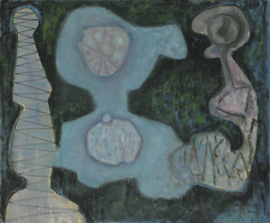
Hudson River
Oil on canvas
Gift of Susan and Steven Hirsch, class of 1971 2005.35.6
Todays post comes from Delphine Douglas, class of 2018 and Art Center Multimedia Student Assistant.
American Stories 1800-1950, the main exhibition of the spring semester at the Art Center, opened on January 29. The docents met with Mr. James Mundy, Director of the Art Center and curator of the show, to learn about the works on display and the curatorial process. Before entering the galleries Mr. Mundy explained that because of the strength of the museum’s collection of American paintings, there are many great works that don’t often get the chance to leave storage.

American, (1872-1930)
Madonna of the Harbor, 1925
Oil on Canvas
Gift of Mr. and Mrs. Stuart P. Feld, 2001.33.2
This exhibition, like XL: Large-Scale Paintings from the Permanent Collection (2015), and Mastering Light: From the Natural to the Artificial (2014) before it, serves as an opportunity to show those works. The exhibition itself spans many years and shows paintings from a wide range of schools, styles, and influences. In addition to the “People,” “Places,” and “Moments” categories used to group the paintings, what makes the exhibition cohesive is, paradoxically, that each of the works is distinct. Each represents a different American story, and though it’s possible to find connections and commonalities among those stories, the show ultimately seems purposefully multifarious. This collage of different stories may say something about the exhibition’s presentation of America and how possible it is to make cohesive statements about anything that’s so vast and complex. When asked if the exhibition had a thesis, Mr. Mundy replied that it was to demonstrate “What is American about American art.”
As Mr. Mundy walked us through the galleries we learned that his decision to separate the show into “People,” “Places,” and “Moments” was influenced by American art history. Art in the United States developed without the strong traditions of religious art, including devotional painting and altar pieces, or patronage that were so important to European art. The American tradition began instead with portrait painting, which became wildly popular and important in the eighteenth century. For example, John Singleton Copley became known as the first great American portrait painter and paved the way for other Americans, even as he left the United States to become a member of the Royal Academy in London. While the exhibition includes a painting by Copley, (Portrait of a Man), the many portraits in the ”People” room may do more to show the importance of portraits in American art. They vary in style and subject and illustrate how important portraiture was during the entire 150 year span seen in the show.

American, 1898-1969
Puddler’s Sunday, 1937
Tempera on board
Gift of Mr. and Mrs. Albert Hackett (Frances Goodrich, class of 1912), 1979.41.1
The “Places” gallery also reflects the history of American art. We see in “Places” not only representations of American space, but also of various important American art movements. For example, the nineteenth-century wall displaying Hudson River School works demonstrates the importance of the movement, and landscape painting as an American tradition. Other works including three by Clarence Kerr Chatterton, a popular Vassar College professor of art, demonstrate the importance of landscape painting in the American realism movement. That the exhibition features landscapes in so many different artistic styles including American impressionism, American modernism, and American Precisionism, illustrates the importance of “places” in American art.
The “Moments” category seems to demonstrate the impossibility of fully exemplifying something so vast as American art from 1800-1950. Mr. Mundy reminded us that much of American art doesn’t fit neatly into the first two categories of the show, and this third room serves as a place to show some of those works from the collection. We can imagine that George Inness’s The Valley of the Shadow of Death (1867) depicts a moment because it

American, 1901-1973
Waterfront, 1939
Oil on Canvas
Purchase, Betsey Mudge Wilson, class of 1956, Memorial Fund
1974.18
seems to represent a scene in the middle of a spiritual event. On the other hand, Georgia O’Keeffe’s Two Figs (1923) is a still life without any reference to time, and stretches the concept of what a moment is. The gallery is a reminder of the huge variety of American art that the exhibition attempts to display, and how enigmatic American art is.
What does join these works is their identity as American paintings. They were influenced by the unique history of this country and reflect the difficulty of defining anything American without varying view points. When we were finishing up in the galleries Mr. Mundy explained that paintings were included both because they edified and delighted. He wanted the exhibition to be an enjoyable way to view works that aren’t usually seen. Remembering that many of the works were included simply because they’re fun to engage with offers an interesting additional perspective that still fits in with the exhibitions’ presentation of American stories.

A Winter View from Newburgh, 1856
Oil on panel
Gift of Matthew Vassar
1864.1.57

American, 1861-1848
Girl Writing
Oil on Canvas
Gift of Ruth Scherm, class of 1945
1995.4.3

Portrait of Concetta Scaravaglione, 1927
Oil on Canvas
Gift of Dr. Edward Scarvalone




